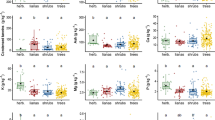Abstract
Dry matter, ash, crude protein, and protein precipitation activity (PPA) of 13 Nepalese tree fodder species were monitored in dried samples prepared monthly between November 1990 and May 1991, and additionally in November 1991, covering the season when they are particularly important as fodder. Monthly levels of dry matter, ash, and crude protein were fairly stable except when there was new leaf growth, although year to year differences in dry matter were found inBrassaiopsis hainla (Bh),Dendrocalamus strictus (Ds),Ficus roxburghii (Fr), andQuercus semecarpifolia (Qs). Tannin PPA fluctuated considerably inArtocarpus lakoocha (Al),Ficus glaberrima (Fg),F. nerrifolia (Fn), Fr,F. semicordata (Fs),Litsea polyantha (Lp), andPrunus cerasoides (Pc), and to a lesser extent in Bh,Castanopsis indica (Ci),C. tribuloides (Ct),Quercus lamellosa (Ql), and Qs. Similar fluctuations in PPA were observed in fresh leaf samples taken weekly. Ds did not have any detectable PPA. Trends in PPA fluctuation were generally similar for trees located at similar altitudes. Fr, Pc, Al, Fn, Ql, and Ci had falling PPAs before shedding leaves. Some of the fluctuations in Fr, Fs, Fg, Pc, and Lp were apparently due to changes in the extractability and quantity of condensed tannins. These fluctuations in PPA may affect the nutritive value of the fodders.
Similar content being viewed by others
References
Anonymous. 1982. Feeding Stuffs (Sampling and Analysis) Regulations. Her Majesty's Stationary Office (HMSO), London, U.K.
Barry, T.N., andForss, D.A. 1983. The condensed tannin content of vegetativeLotus pedunculatus, its regulation by fertiliser application, and effect on protein solubility.J. Sci. Food Agric. 34:1047–1056.
Barry, T.N., Manley, T.R., andDuncan, S.J. 1986. The role of condensed tannins in the nutritional value ofLotus pedunculatus for sheep. 4 Sites of carbohydrate and protein digestion as influenced by dietary reactive tannin concentration.Brit. J. Nutr. 55:123–137.
Dawra, R.K., Makkar, H.P.S. andSingh, B. 1988. Protein-binding capacity of micro quantities of tannins.Anal. Biochem. 170:50–53.
Du Toit, J.T., Bryant, J.P., andFrisby, K. 1990. Regrowth and palatability ofAcacia shoots following pruning by African savanna browsers.Ecology 71:149–154.
Giri, M.K. 1990. Fodder production in Nepal—a review,in J. Wiseman, and D.J.A. Cole (eds.) Livestock in the Hills of Nepal, 2. Butterworths, London, 456 pp.
Hagerman, A.E. 1987. Radial diffusion method for determining tannin in plant extracts.J. Chem. Ecol. 13:437–449.
Hagerman, A.E. 1988. Extraction of tannin from fresh and preserved leaves.J. Chem. Ecol. 14:453–461.
Hagerman, A.E. 1989. Chemistry of tannin-protein complexation,in R.W. Hemingway and J.J. Karchesy (eds.). Chemistry and Significance of Condensed Tannins. Plenum Press, New York, pp 553.
Hagerman, A.E., andButler, L.G. 1989. Choosing appropriate methods and standards for assaying tannin.J. Chem. Ecol. 15:1795–1810.
Kumar, R., andSingh, M. 1984. Tannins: their adverse role in ruminant nutrition.J. Agric. Food Chem. 32:447–453.
Leiner, I.E. 1990. Naturally occurring toxic factors in animal feedstuffs, pp. 377–394,in J. Wiseman and D.J.A. Cole (eds.). Feedstuff Evaluation. Butterworths, London.
Mahato, S.N., andSubba, D.B. 1988. Nutritional evaluation of fodder at Pakhribas Agricultural Centre, Dhankuta, pp. 20–24,in Proceedings of the 2nd Meeting of the Working Group on Fodder Trees, Forest Fodder and Leaf Litter. Occasional paper 2/88 Dec. 88. Forest Research Information Centre (FRIC), Kathmandu, Nepal.
Makkar, H.P.S., andSingh, B. 1991. Effect of drying conditions on tannin, fibre and lignin levels in mature oak (Quercus incana) leaves.J. Sci. Food Agric. 54:323–328.
Makkar, H.P.S., Dawra, R.K., andSingh, B. 1991. Tannin levels in leaves of some oak species at different stages of maturity.J. Sci. Food Agric. 54:513–519.
Mangan, J.L. 1988. Nutritional effects of tannins in animal feeds.Nutr. Res. Rev. 1:209–231.
Mauffette, Y., andOechel, W.C. 1989. Seasonal variation in leaf chemistry of the coast live oak (Quercus agrifolia) and implications for the California oak moth (Phryganidia californica)Oecologia 79:439–445.
Mueller-Harvey, I. 1989. Identification and importance of polyphenolic compounds in crop residues, pp. 88–109,in A. Chesson and E.R. Orskov (eds.) Physicochemical Characterisation of Plant Residues for Industrial and Feed Use. Elsevier Applied Science, London.
Padmaja, G. 1989. Evaluation of techniques to reduce assayable tannin and cyanide in cassava leavesJ. Agric. Food Chem. 37:712–716.
Panday, K.K. 1982. Fodder trees and tree fodder in Nepal. Swiss Development Cooperation and the Swiss Federal Institute of Forestry Research, Switzerland, 107 pp.
Porter, L.J., Hrstich, L.N., andChan, B.G. 1986. The conversion of procyanidins and prodelphinidins to cyanidin and delphinidin.Phytochemistry 25:223–230.
Upton, P., andRobinson, P.J. 1988. Fodder tree survey of South Lalitpur, pp. 34–36,in Proceedings of the 2nd Meeting of the Working Group on Fodder Trees, Forest Fodder and Leaf Litter. Occasional paper 2/88 Dec 1988. Forest Research Information Centre (FRIC). Kathmandu, Nepal.
Vaithiyanathan, S., andSingh, M. 1989. Seasonal changes in tannin contents in some tropical feeds in arid regionsIndian J. Anim. Sci. 59:1565–1567.
Van Hoven, W. 1991. Mortalities in kudu (Tragelaphus strepsiceros) populations related to chemical defense in trees.J. Afr. Zool. 105:141–145.
Waterman, P.G., Ross, J.A.M., andMcKey, D.B. 1984. Factors affecting levels of some phenolic compounds, digestibility, and nitrogen content of the mature leaves ofBarteria fistulosa (Passifloraceae).J. Chem. Ecol. 10:387–401.
Author information
Authors and Affiliations
Rights and permissions
About this article
Cite this article
Wood, C.D., Tiwari, B.N., Plumb, V.E. et al. Interspecies differences and variability with time of protein precipitation activity of extractable tannins, crude protein, ash, and dry matter content of leaves from 13 species of Nepalese fodder trees. J Chem Ecol 20, 3149–3162 (1994). https://doi.org/10.1007/BF02033717
Received:
Accepted:
Issue Date:
DOI: https://doi.org/10.1007/BF02033717



